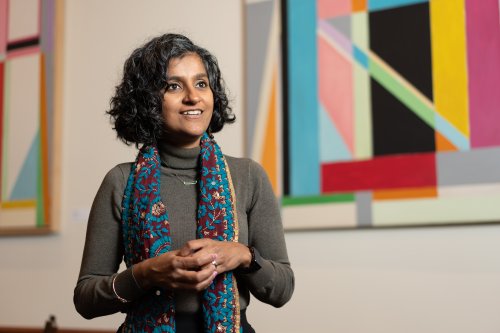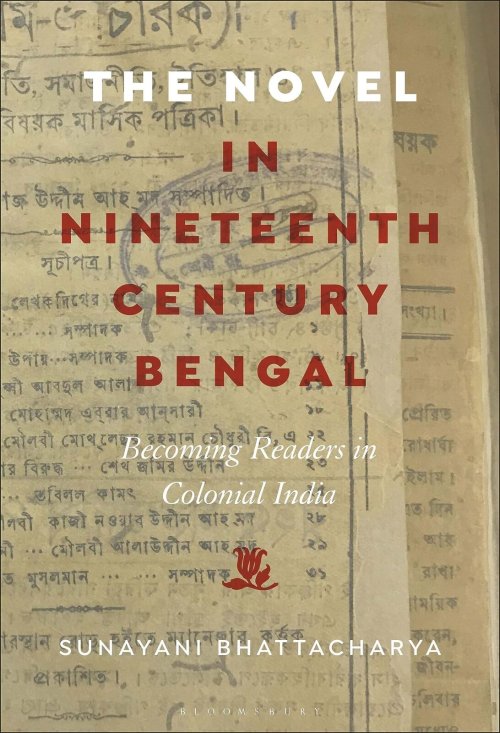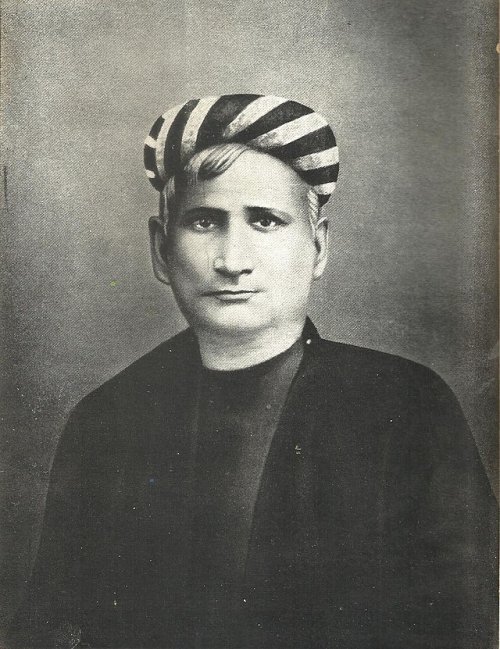
The story behind the stories: Sunayani Bhattacharya explores how a new kind of literature was written and read. She also details how archival research, her grandmother’s insistence, and her willingness to take chances helped her to uncover the rise of the novel in India. / Photo by Francis Tatem
Scholar at Work: How Sunayani Bhattacharya Turns the Focus of Literary Analysis onto the Reader, Connecting Past with Present
‘The Novel in Nineteenth-Century Bengal’ traces development of a new form of literature in Bengal, revealing how society and reading itself changed. Bhattacharya is also leading work on a project by SMC faculty to transform curriculum in the humanities.
“At Work” is a series that highlights Saint Mary’s faculty and staff at work in the world. Artists, writers, scholars, scientists—we sit down and dive deep into their latest projects.
When Sunayani Bhattacharya completed her undergraduate studies at Jadavpur University in Kolkata, she wasn’t planning on getting her PhD, much less writing a book. After earning her MA in English at the University of South Florida, she returned to India and spent a year working at the School of Cultural Texts and Records at Jadavpur University. Eventually, she decided to go back to school to pursue her PhD in Comparative Literature at the University of Oregon.

Today, Bhattacharya is an associate professor of English at Saint Mary’s and a scholar whose work has encompassed world literature and postcolonial studies. She is also the author of The Novel in Nineteenth-Century Bengal, published by Bloomsbury in 2023. Balancing literary analysis with touching anecdotes about her life growing up in India, Bhattacharya explores how Bengalis took colonial notions of grammar, language, and writing, and established their own ways of reading and writing novels.
The Novel in Nineteenth-Century Bengal grew out of Bhattacharya’s doctoral dissertation. “I like to think of the book as a story,” she says. “It started when I had just finished my PhD exams. I’d been thinking about the novel for a while, but then I started thinking about what it means to read a novel.” She recalls her dissertation advisor asking, “Why don’t you write about the reader? You keep going back to the reader in the way that you approach the novel.”
Reading, Translation, and Reading in Translation
Another moment of inspiration for Bhattacharya came from one of her students. “I was teaching a comparative literature class, and one of my students said that they knew how to read English language novels, but that they didn’t know how to read in translation.” This experience led Bhattacharya to consider how the language or languages that we speak and write in change how we read different texts.
Bhattacharya turns her scholarly lens on the effect language has on culture—and vice versa—in 1800s Bengal. She discusses the flexible, almost tumultuous state of language in the region and how writers helped to change language conventions with their novels. One such writer is Bankimchandran Chattopadhyay (1838–94), also known as Bankim, who is widely regarded to have written the first Bengali novel and established the genre. That said, Bhattacharya argues that Bankim’s works are just one contribution to the reading process that allowed novels to flourish.
Several texts quoted in The Novel in Nineteenth-Century Bengal were translated into English by Bhattacharya herself, one of the first steps in her process to understand the Bengali novel as it took form. Of the two primary novelists she examined, only Bankim’s works have been widely translated. “But the translations are really archaic,” she says. “And I don’t like them.” The existing translations also failed to show how Bankim experiments with language, something Bhattacharya wanted to emphasize in her book. So her new translations include Bankim’s play on language that previous translations missed.

Writing and the Power of the Archive
Bhattacharya has taught English at Saint Mary’s since 2017. She primarily teaches courses on nineteenth and twentieth-century Anglophone and world literature. “At Saint Mary’s, I had the benefit of not having a lot of pressure to write a book,” she says, as compared to the untold pressure at some institutions that can diminish faculty commitment to teaching. Bhattacharya was also the recipient of the 2019 Provost Research Grant, which allowed her to travel to India to complete her archival research. Though she was initially planning to do research in Kolkata, a friend advised her to visit the Asiatic Society of Mumbai—more than 1,800 kilometers away, on India’s west coast. Bhattacharya was initially skeptical; the state language of Mumbai is Marathi, and Bhattacharya works in Bengali. But she decided to take a chance.
“The best thing about an archive is that you go in with all these questions, but very quickly you realize that the archive guides you rather than you imposing onto the archive,” she says. By allowing the research to guide her, she found journals, catalogs, and reports at the Asiatic Society about the history of the printed book and the early book market. This research shaped the first chapter of her book and revealed the similarities between our current book market and the book market in the 19th century.
A Personal Touch: Criss-cross Greens
The Novel in Nineteenth-Century Bengal is dedicated to “the women who taught me to dream of criss-cross greens.” Those greens would be part of the iconic image of a university campus with wide lawns and intersecting footpaths. “My grandmother never really left Bengal, so she had this image in her mind of a university campus,” Bhattacharya says. “From a very young age, I had the image of criss-cross greens as somewhere you want to get, whether you get it via writing a book or some other way.”
"The best thing about an archive is that you go in with all these questions, but very quickly you realize that the archive guides you rather than you imposing onto the archive."
Bhattacharya’s book honors and thanks the women in her life who inspired her to pursue academia. “Even before I began working on my dissertation, let alone a book, I had my dedication ready,” she says.
The presence of Bhattacharya’s grandmother, Sumitra Bose, is felt throughout The Novel in Nineteenth-Century Bengal, particularly in the fourth chapter, where Bhattacharya describes the impact a story written by Mosharraf Hossain—the book’s second primary novelist—had on her grandmother as a girl. Through her research of the cultural context and impact of Hossain’s second novel Biśād Sindhu, Bhattacharya was also able to understand her grandmother in a way she hadn’t before.

Her grandmother also introduced her to Bankim’s writings, although Bhattacharya hated his books at first; the Bengali felt old-fashioned and absurdly formal to her. “I was seven, and I thought, You are bonkers. It was a tiny, velvet-bound book, shaped like a wallet. She quite literally sat me down and told me that I had to read it.” So Bhattacharya forged ahead, reading the novel page after painstaking page, until she began to enjoy it. Without her grandmother’s push to read foundational Bengali literature, Bhattacharya’s book might never have been written.
Leading Work on an NEH Grant
Along with publishing her first book in 2023, Bhattacharya was among seven faculty who achieved tenure at Saint Mary’s last year. She is also leading the Humanities at the Core project, which aims to create new courses that teach hands-on skills in the liberal arts.
The project is supported by the National Endowment for the Humanities through the Spotlight on the Humanities grant program. Bhattacharya compares the courses being developed at SMC to fine arts classes, where students can learn humanities practices just as they learn artistic practices. “We wanted to give faculty space to develop more creative courses that are not fine arts related, but instead humanities-oriented,” she says. “For current and prospective students, this will lead to courses that equip them with practical and transferable skills in the humanities classroom, which they can then take into the world beyond SMC.”
Listen to What’s Next
Alongside teaching classes and managing Humanities at the Core, Bhattacharya is already at work on her next project. “I’m looking at an analogous question: How did people learn to listen to the radio at the beginning of the twentieth century in India?”
Though this project is still in its early stages, Bhattacharya is planning to cover the advent of broadcasting sports games, particularly cricket; radio dramas; and how religious radio programs help to turn religion into culture.
In an era where podcasts, audio dramas, and sportscasting are a robust part of the entertainment landscape, Bhattacharya’s next project is sure to uncover more trends that are strikingly similar to today. She asks us to consider how and why we consume media the way we do—and how that consumption changes cultures, both in the past and in the future.
READ MORE: “Saint Mary’s Announces 2022-2023 Provost Grant Recipients”
LEARN MORE: “Saint Mary’s Faculty Earn Multiple NEH Grants for Innovations in Curriculum.”
Jordan Sapp MFA ’25 is a graduate editorial fellow with the Office of Marketing & Communications at Saint Mary’s. Write her.